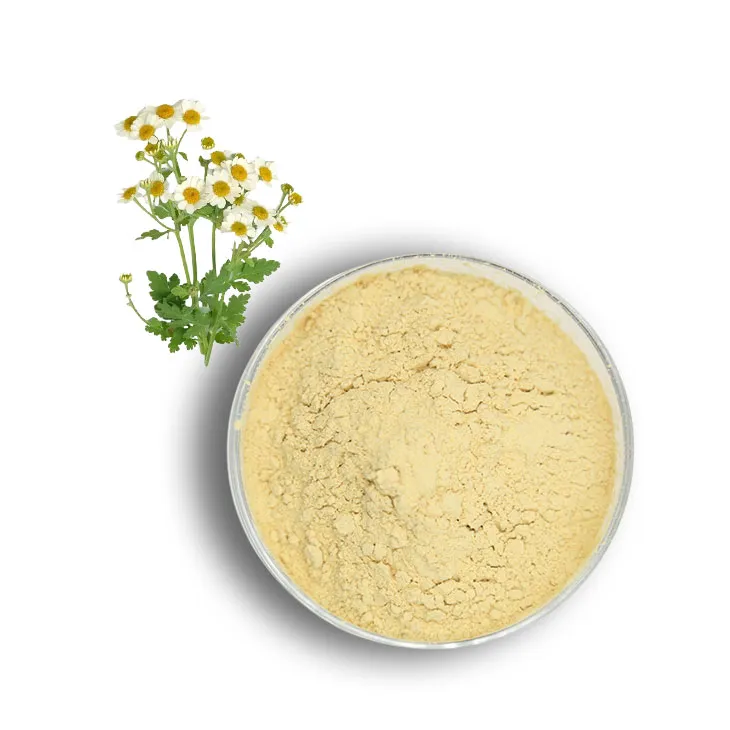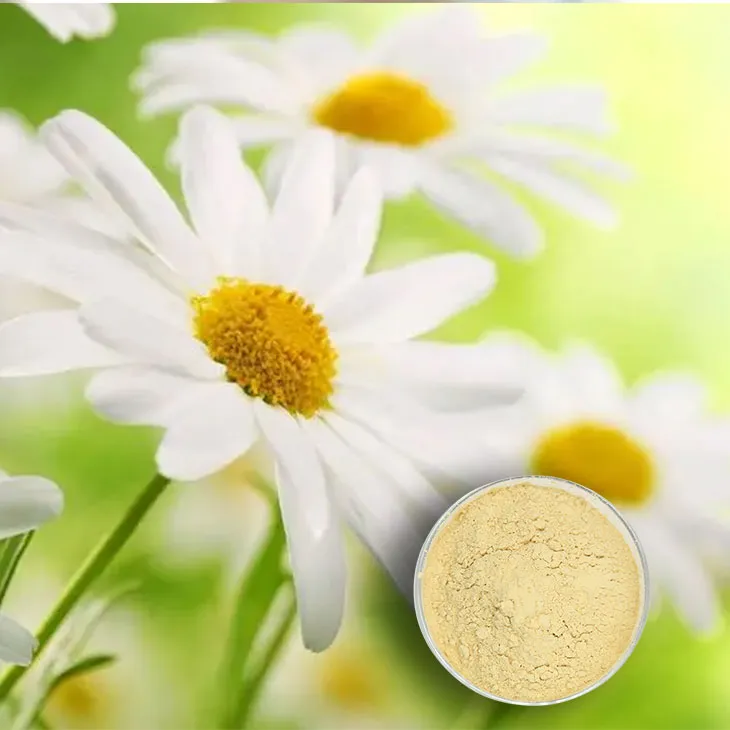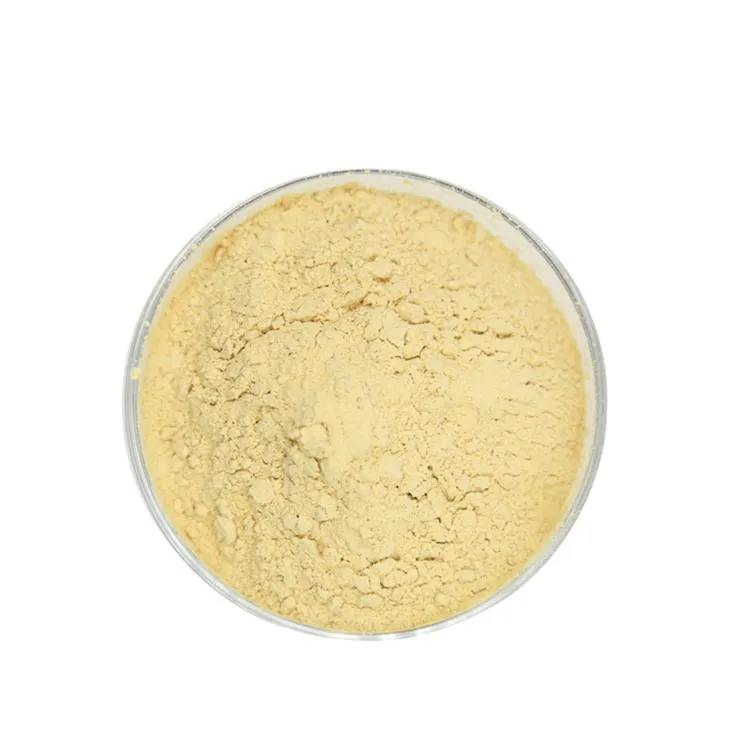- 0086-571-85302990
- sales@greenskybio.com
Manufacturer of Organic Feverfew Extract Powder.
2024-11-26

Introduction
Organic Feverfew Extract powder manufacturers are of great significance in the natural products industry. Feverfew, a plant known for its potential health benefits, has been used in traditional medicine for centuries. The extract powder form of this organic plant is becoming increasingly popular in various applications such as dietary supplements, herbal remedies, and the cosmetic industry. This article provides a detailed look at the aspects involved in the manufacturing of organic Feverfew Extract powder.

Sourcing of Raw Materials
1. Importance of High - Quality Raw Materials
The quality of the final organic Feverfew Extract powder is highly dependent on the quality of the raw materials, which are the white feverfew plants. High - quality plants are rich in the bioactive components that give the extract its beneficial properties. For example, parthenolide, one of the key compounds in feverfew, is responsible for many of its potential medicinal effects. Thus, manufacturers must ensure that they start with the best possible raw materials.
2. Working with Farmers or In - house Cultivation
Manufacturers have two main options when it comes to obtaining white feverfew plants. They can either work closely with farmers or have their own cultivation facilities.
-
When working with farmers, manufacturers need to establish good relationships. This involves providing clear guidelines on organic farming practices, quality requirements, and pricing. They may also offer support in terms of agricultural knowledge and technology to ensure that the farmers can produce high - quality feverfew plants.
-
Having in - house cultivation facilities gives manufacturers more control over the entire process. They can directly manage soil quality, water sources, and pest management. However, it also requires significant investment in terms of land, equipment, and labor.
3. Organic Farming Practices
Adhering to organic farming practices is crucial for organic feverfew extract powder manufacturers.
-
Soil Quality: The soil must be free from synthetic fertilizers, pesticides, and other contaminants. Organic matter is added to improve soil fertility, and soil testing is regularly carried out to monitor nutrient levels. For example, compost made from natural materials like plant waste and animal manure can be used to enrich the soil.
-
Water Sources: Clean and unpolluted water is essential for the growth of feverfew plants. Manufacturers need to ensure that the water used for irrigation comes from reliable sources. In some cases, they may need to treat the water to remove any potential contaminants.
-
Pest Management: Instead of using synthetic pesticides, organic pest management methods are employed. This can include biological control, where natural predators of pests are introduced, or the use of natural pesticides derived from plants like neem oil.

Production Excellence
1. Harvesting and Initial Processing
Once the feverfew plants have reached the appropriate stage of growth, they are harvested. Harvesting must be done carefully to avoid damaging the plants and to ensure that the maximum amount of bioactive compounds are retained.
After harvesting, the plants are subjected to initial processing. This may include cleaning to remove dirt, debris, and any unwanted parts of the plant. The plants are then dried, either in the sun or using specialized drying equipment. Drying helps to preserve the plants and prepares them for the extraction process.
2. The Extraction Procedure
The extraction procedure is a critical step in the manufacturing of organic feverfew extract powder.
-
Maximizing Yield of Beneficial Compounds: Manufacturers aim to extract as much of the desired bioactive compounds as possible. This requires careful selection of the extraction method. Solvent extraction is commonly used, where a suitable solvent such as ethanol or ethyl acetate is used to dissolve the bioactive compounds from the plant material. The choice of solvent depends on factors such as the solubility of the target compounds and the safety and environmental impact of the solvent.
-
Minimizing Degradation: During the extraction process, it is important to minimize the degradation of the bioactive compounds. Temperature, pressure, and extraction time all play a role in this. For example, high temperatures can cause the breakdown of parthenolide, so the extraction is usually carried out at a carefully controlled temperature. Similarly, excessive pressure or long extraction times can also lead to degradation.
3. Post - extraction Processing
After the extraction is complete, the resulting extract undergoes further processing.
-
Purification: Purification is carried out to remove any impurities that may be present in the extract. This can be done using techniques such as filtration, centrifugation, or chromatography. Filtration can remove solid particles, while centrifugation can separate heavier components from the extract. Chromatography is a more sophisticated technique that can separate different compounds based on their chemical properties.
-
Drying: The purified extract is then dried to transform it into a fine powder. Spray drying or freeze - drying can be used. Spray drying involves spraying the extract into a hot air stream, which causes the water to evaporate quickly, leaving behind a powder. Freeze - drying, on the other hand, involves freezing the extract and then removing the water under vacuum, which results in a powder with high quality and good stability.

Quality Assurance and Testing
1. Importance of Quality Assurance
Quality assurance is essential in the manufacturing of organic feverfew extract powder. It ensures that the product meets the required standards in terms of safety, efficacy, and quality. Without proper quality assurance, there is a risk of producing a sub - standard product that may not deliver the expected benefits or may even pose a risk to consumers.
2. Types of Tests
Manufacturers conduct various types of tests at different stages of production.
-
Chemical Analysis: Chemical analysis is carried out to determine the content of important compounds in the extract, such as parthenolide. High - performance liquid chromatography (HPLC) is a commonly used technique for this purpose. By accurately measuring the parthenolide content, manufacturers can ensure that the extract has the desired potency.
-
Microbiological Testing: Microbiological testing is done to ensure the safety of the product. This includes testing for the presence of bacteria, fungi, and other microorganisms. Tests such as total plate count, yeast and mold count, and pathogen detection are carried out. If any harmful microorganisms are detected, the product may need to be treated or discarded.
-
Stability Testing: Stability testing is crucial to determine the shelf - life of the organic feverfew extract powder. The product is subjected to different storage conditions, such as different temperatures and humidity levels, over a period of time. Samples are taken at regular intervals and tested for changes in chemical composition, appearance, and microbial growth. Based on the results of stability testing, manufacturers can determine an appropriate expiration date for the product.

Industry Standards and Regulations
1. Organic Certification Requirements
To label their product as "organic," manufacturers must meet the requirements of organic certification bodies. These requirements cover various aspects of the production process, from the sourcing of raw materials to the final packaging.
-
For the raw materials, the feverfew plants must be grown according to organic farming standards, as mentioned earlier. This includes using only approved organic fertilizers and pest control methods.
-
During the manufacturing process, strict separation must be maintained between organic and non - organic materials to prevent cross - contamination. The use of additives and processing aids must also be in line with organic regulations.
Manufacturers need to keep detailed records of their production processes to prove compliance with organic certification requirements. These records are subject to inspection by the certification bodies.
2. Food Safety Regulations
Since organic feverfew extract powder may be used in food supplements or other food - related products, manufacturers must comply with food safety regulations.
-
Good Manufacturing Practice (GMP) guidelines must be followed. This includes aspects such as proper facility design and maintenance, hygienic handling of raw materials and products, and employee training in food safety.
-
Labeling requirements must be met. The label should clearly state the product name, ingredients, usage instructions, and any relevant warnings. In addition, if the product makes any health claims, these must be supported by scientific evidence.
3. Export/Import Regulations
If manufacturers operate in the international market, they need to be aware of and comply with export/import regulations.
-
Different countries may have different requirements for the import of organic products. For example, some countries may require additional documentation, such as a certificate of origin or a phytosanitary certificate.
-
Tariffs and trade agreements can also affect the export and import of organic feverfew extract powder. Manufacturers need to stay informed about these factors to ensure smooth international trade operations.

Conclusion
Manufacturers of organic feverfew extract powder face a complex set of challenges and requirements. From sourcing high - quality raw materials through organic farming practices, to achieving production excellence, ensuring quality assurance, and complying with industry standards and regulations, every step in the process is crucial. By carefully managing these aspects, manufacturers can produce a high - quality product that meets the needs of consumers in the natural products industry, whether it is for dietary supplements, herbal remedies, or cosmetic applications.
FAQ:
What are the key factors in sourcing raw materials for organic feverfew extract powder?
Manufacturers need to ensure a reliable source of high - quality white feverfew plants. They often work closely with farmers or have their own cultivation facilities. Organic farming practices are crucial, which involve strict control over soil quality, water sources, and pest management to obtain plants rich in bioactive components for an effective extract.
How is the production process of organic feverfew extract powder?
The production process is complex. After harvesting, the plants are carefully processed. The extraction procedure regulates temperature, pressure, and time to maximize the yield of beneficial compounds and minimize degradation. Post - extraction processing such as purification and drying is carried out to turn the extract into a fine powder with consistent quality.
What quality assurance tests are done for organic feverfew extract powder?
Manufacturers conduct various tests. Chemical analysis is done to determine parthenolide content. Microbiological testing ensures safety, and stability testing guarantees the product's shelf - life. These tests are carried out at different production stages from raw materials to the final packaged product.
Why is it important for manufacturers to comply with industry standards and regulations?
It is non - negotiable for manufacturers to comply with industry standards and regulations. If they operate in the international market, they need to be well - versed in organic certification requirements, food safety regulations, and export/import regulations. This ensures that the product reaches consumers with the highest level of safety and quality.
How can consumers ensure the quality of organic feverfew extract powder?
Consumers can look for products from manufacturers that follow strict quality assurance protocols. Check for organic certifications and ensure that the product has passed relevant safety and quality tests such as chemical analysis for parthenolide content, microbiological and stability testing.
Related literature
- Organic Feverfew: Cultivation and Extraction"
- "Quality Control in Organic Feverfew Extract Powder Production"
- "The Regulatory Landscape for Organic Feverfew Extract in the Global Market"
- ▶ Hesperidin
- ▶ citrus bioflavonoids
- ▶ plant extract
- ▶ lycopene
- ▶ Diosmin
- ▶ Grape seed extract
- ▶ Sea buckthorn Juice Powder
- ▶ Beetroot powder
- ▶ Hops Extract
- ▶ Artichoke Extract
- ▶ Reishi mushroom extract
- ▶ Astaxanthin
- ▶ Green Tea Extract
- ▶ Curcumin Extract
- ▶ Horse Chestnut Extract
- ▶ Other Problems
- ▶ Boswellia Serrata Extract
- ▶ Resveratrol Extract
- ▶ Marigold Extract
- ▶ Grape Leaf Extract
- ▶ blog3
- ▶ blog4
-
Selenium yeast
2024-11-26
-
Marigold Extract
2024-11-26
-
White Willow Bark Extract
2024-11-26
-
Phellodendron Extract
2024-11-26
-
Lemon Balm Extract
2024-11-26
-
Citrus bioflavonoids
2024-11-26
-
Kelp Extract Powder
2024-11-26
-
Black Rice Extract
2024-11-26
-
Lycopene
2024-11-26
-
Clove Powder
2024-11-26





















